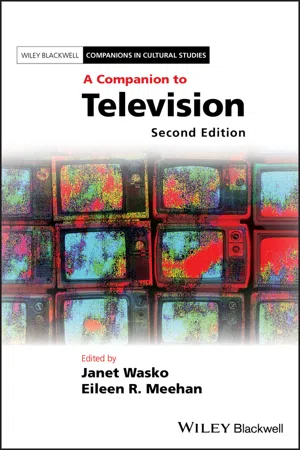
- English
- ePUB (mobile friendly)
- Available on iOS & Android
A Companion to Television
About this book
The latest edition of the acclaimed volume on television studies, featuring new original essays from leading scholars in the field
Although the digital age has radically altered the media and communications landscape worldwide, television continues to play a significant part of our lives. From its earliest beginnings through to the present day, television and its influence has been the subject of extensive study, critique, and analysis. A Companion to Television brings together contributions from prominent international scholars comprising a wide range of perspectives on the medium. Original essays define television in its current state, explore why it is still relevant, survey the ways in which television has been studied, discuss how television has changed, and consider what television might look like in the future.
Now in its second edition, this compendium includes fresh chapters that cover technological changes affecting television, contemporary approaches to understanding television audiences, new programming trends and developments, and more. Addressing nine key areas of television studies, such as industry, genres, programs, and audiences, the Companion offers readers a balanced, well-rounded, integrative approach to scholarship in the field. This volume:
- Provides overviews of extensive original research from leading scholars and theorists
- Examines television's development and significance in various regions of the world
- Includes national and regional outlines of television around the world
- Features theoretical overviews of various critical approaches to television studies
- Explores historical, economic, institutional, political, and cultural issues studied by media scholars
Presenting diverse perspectives on topics ranging from television advertising to satirical representations of the industry, A Companion to Television, Second Edition is an invaluable resource for those in undergraduate courses in television studies, as well as in general media studies and communications.
Frequently asked questions
- Essential is ideal for learners and professionals who enjoy exploring a wide range of subjects. Access the Essential Library with 800,000+ trusted titles and best-sellers across business, personal growth, and the humanities. Includes unlimited reading time and Standard Read Aloud voice.
- Complete: Perfect for advanced learners and researchers needing full, unrestricted access. Unlock 1.4M+ books across hundreds of subjects, including academic and specialized titles. The Complete Plan also includes advanced features like Premium Read Aloud and Research Assistant.
Please note we cannot support devices running on iOS 13 and Android 7 or earlier. Learn more about using the app.
Information
Part I
Introduction
Introduction
Television (tel•e•vi•sion.)Pronunciation /tɛlɪˈvɪʒ(ə)n//ˈtɛlɪvɪʒ(ə)n/Origin Early 20th century: from tele‐ ‘at a distance’ + vision.
- [mass noun] A system for converting visual images (with sound) into electrical signals, transmitting them by radio or other means, and displaying them electronically on a screen.
- The activity, profession, or medium of broadcasting on television.
- Television programmes.
- A device with a screen for receiving television signals.
- Lexico.com (Dictionary.com and Oxford University Press), https://www.lexico.com/en/definition/television
What is Television?
Philo began laying out his vision for what television could become. Above all the … television would become the world's greatest teaching tool. Illiteracy would be wiped out. The immediacy of television was the key. As news happened viewers would watch it unfold live; no longer would we have to rely on people interpreting and distorting the news for us. We would be watching sporting events and symphony orchestras. Instead of going to the movies, the movies would come to us. Television would also bring about world peace. If we were able to see people in other countries and learn about our differences, why would there be any misunderstandings? War would be a thing of the past(Schwartz 2002, p. 113).
Why Should We Still Bother to Understand Television?
From its public marketing in the 1940s to the present day, television can be listed as one of the most profound, if not the most profound, influences on human history. Television has affected every aspect of our lives including history, science, politics, culture and social mores. It is impossible to imagine a world without television, and most of us take for granted the way television has shaped and defined our society, and our lives(The History Channel 1996).
Table of contents
- Cover
- Table of Contents
- Notes on Contributors
- List of Tables and Figures
- Part I: Introduction
- Part II: Theoretical Overview
- Part III: History
- Part IV: Industry
- Part V: Genres
- Part VI: Programs
- Part VII: Audiences
- Part VIII: International Case Studies
- Index
- End User License Agreement